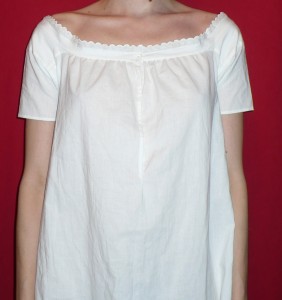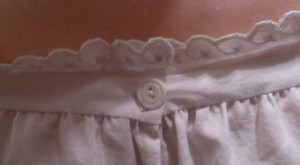Stitching Away
May 20th, 2011
I haven’t had much sewing time in the past few evenings (thanks in part to a humiliating mishap on Tuesday night), but I’m still making steady progress on the petticoat for my Empire gown. Keeping me company, I’ve got everything a girl could ask for: Yesterday USA internet radio, a handsome husband in the easy chair, and my wee sewing bird.
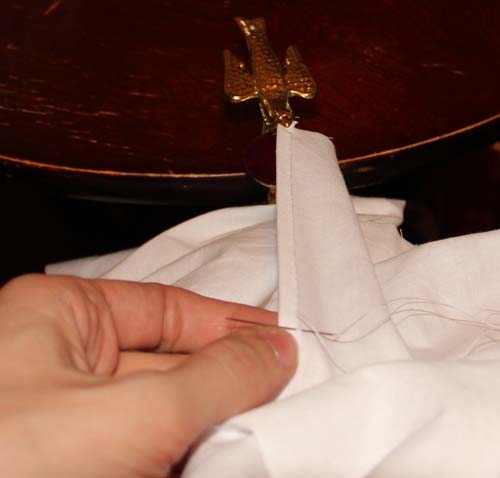
Sewing School
April 10th, 2011
Last night, my hand-sewing partner (and co-founder of the New York Nineteenth Century Society) and I taught an introductory hand-sewing class at Trade School on the Lower East Side. The concept of Trade School is very close to genius — people with unusual skills are invited to propose classes. People who want to take the classes promise to bring barter items (based on a list provided by each teacher) in lieu of payment. They’ve had two semesters so far — this time around, the classroom was in a building owned by Old St. Patrick’s Cathedral. It was an old schoolroom, so there were wonderful chalk boards, bookshelves, and those wooden and metal chairs with desks attached.
When our hand-sewing class was announced, we planned to accept 15 attendees. Those seats “sold” out within the first weekend! In the end, 9 lovely people showed up for the class. We sat around in a circle, and talked about some of the social history of hand-sewing while learning basic stitches. Some of our class were experienced sewers who wanted to learn new techniques, but even those who had never used a needle before did a wonderful job sewing their sample seams. It was also exciting to hear how each person planned to use their new skills.
Because we only had 90 minutes, we stuck to sewing and felling, as demonstrated in this video that we produced in advance of our very first hand-sewing class last year (taught at The Old Stone House in Brooklyn).
I’m now thinking about an instruction booklet for hand-sewing stitches; about making my own hand-sewing sampler; and about organizing an ongoing class where people could learn all the various stitches and techniques required for garment construction. We are on a crusade to bring back hand-sewing!!
Lecture Report
March 24th, 2011
Last night, I gave a “hands-on” presentation at the museum where I work. It was called Hand-Sewing in the 1850s — 60 Years before the Triangle Shirtwaist Fire, presented in collaboration with Remember the Triangle Fire Coalition’s 100th anniversary memorial.
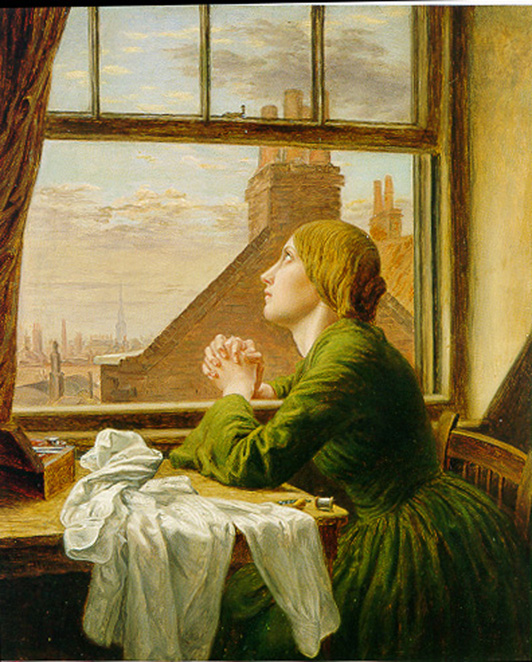
The Song of the Shirt, by Anna Blunden — one of the illustrations I used in my talk.
To my great delight, 35 people turned out for the lecture, despite miserable left-over-winter weather that included rain, snow, sleet, hail, and thunder. Everyone seemed very interested in the topic at hand, and after the slides were finished, the crowd proved their good nature by trying out some of the hand-sewing stitches we’d been discussing. I was particularly pleased to meet so many fellow sewers, including two ladies who work at an historic farm, and a costumer from a local ballet company!
I recorded the talk for some friends who couldn’t be there, and though I haven’t had the courage to listen to it myself, my husband assures me it was quite presentable. I wonder when I’ll have the chance to do it again, and what I shall talk about.
Now back to my stays…
Stitch Not In Time
March 4th, 2011
Alright, alright, I’ve learned my lesson. Don’t make hand-sewn undergarments out of plain muslin. It’s oh, so tempting at less than $2 a yard (actually, it might as well be free — I’m still sewing through a bolt of white cotton muslin that my mother bought for me a decade ago). But look what happened to the chemise I made last year. I’ve only worn it three or four times too.
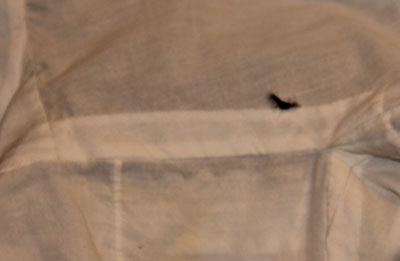
I think it might have ripped while I was fitting my new stays, twisting around this way and that, trying to slide into them without unlacing. Drat!
Always one to look for the silver lining, I have decided to use this as an excuse to practice my mending. Many of the manuals that I used to learn 19th-century hand-sewing have extensive sections on mending, including this catechism from England’s Finchley School manual Plain Needle-Work, in All Its Branches, 1852:
PATCHING.
Q. You have told me how you would manage a sheet, or any large coarse article; but should the linen, cotton, or whatever the material may be requiring a patch, be of a finer description, or printed in colours, how would you proceed?
A. I would cut the piece with which I intended to repair, exactly to a thread, and place it on the decayed or worn part, to a thread also, and on the right side; taking care, should the article have any pattern, to fix the patch so as to make the parts of the pattern correspond.
Q. “What next?
A. I then tack the patch on slightly, to keep it ia its place, and sew it at the edges in the manner of a hem, taking care to manage the corners neatly.
Q. And then?
A. Having made the cloth very flat and smooth, I carefully cut out the old piece on the wrong side, leaving sufficient to form a hem, the same as in patching a sheet.
Q. How do you manage to make the hem sit neatly at the corners?
A. I nick it a little, at each of the four corners, carefully turning-in the raw edges, making allowance for turning them in, and then proceed with the hem.
And just in case I’m tempted to put speed ahead of quality (especially since I need to rip out the armhole facing and hem it back down again over the patch):
“Patches should always be well shaped, and basted on perfectly even; a round, angular, or slanting patch, is the sure sign of a slut.”
The Girl’s Own Book, by Lydia Maria Child, 1853
Anyone having a sale on Kona cotton broadcloth? Or should I finally break into that stash of cream linen for my next chemise?
Past Projects: Shift
February 13th, 2011
This garment, my first (and only, to date) 1850s shift, aka chemise*, is a bit of a jumble. It looks fine from a distance, but the fact is I alternated between 5 different sets of directions, which occasionally contradicted each other outright. There were also a few spots (mostly around the neckline) that every set of directions glossed over, so I simply guessed. I need to start visiting costume collections to look at extant garments to see all those little details!
The 1850s was a time of change for most female undergarments, many of which had remained stable in shape for decades previously. Last summer I made a shift from the 1838 Workwoman’s Guide. It was much more simply cut than this one, and ended up being enormous because I made it according to one of the larger sizes given. I gave it away to a photographer for use as a prop.
I do plan to experiment some more with the Workwoman’s Guide patterns (and will probably give away the results), until I get the sizing right. Even though the shape they take is old fashioned compared to illustrations in 1850s magazines, it’s still very much acceptable for the period. Makes sense, since many of the women who were sewing shifts in the 1850s had learned to make them a decade earlier.
As you’ve probably guessed by my previously stated predilections, this shift is entirely hand sewn. I embroidered the scalloped band, based on the simplest pattern I could find in Godey’s.
*Like the shape of the shift, the name also changed in the 1850s. By the end of the decade most people in America and England had adopted the French moniker Chemise.
« Newer Posts — Older Posts »
